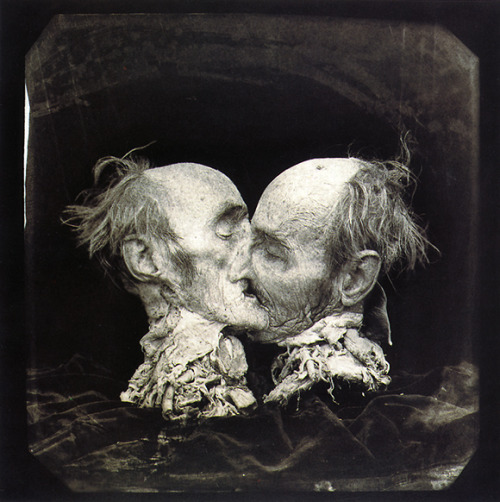Continuing with the previous entries presented to the last three photographers who in my opinion is based on fear influence your work. The next author, Joel Peter Witkin, you could define aesthetically and bizarre, his work marked by different cut enough pictorial influences, is a catalog of horror, of human horror, as they were and remain the Freak Show. Witkin's aesthetic is an aesthetic that
The kiss (Joel Peter Witkin)
|
seeks to offend the audience, seeks to reach him through impact, but also shows us different realities, between the macabre and the surreal, dreamlike realities of this author have a strong aesthetic sense , while in his portraits more accessible, presents us with bodies visible marks of the autopsy, in their most creative images we can see members, and even severed heads. Are these issues, not without a certain morbidity, which presents yet poses a reflection on the image, the image and sense of self, while the opposite has opposite charges seeking perfection.
It is through this oposion to royalties where the author throws us that fear, accompanied by an aesthetic that makes us ask ourselves about the sample's image, and not only our physical image, if not moral image, or more transcendental. Is this question more than the aesthetics of his images that to us as viewers we face both the fear of looking at ourselves and also the challenge of seeing what we find.
Photography from the series
Sniper Shot (Nobuyoshi Araki)
|
The following authors, we moved to the Pacific, more specifically to Japan. Nobuyoshi Araki, the creator, heir to the Eastern culture, we also proposed the idea of fear through your images within images Araki, not without some controversy, we can see certain shades of fetishism, where such images is played between sexuality and the bizarre, give us a sample court primal fear of social and Araki seeks to convey, because beyond the image itself, we see the oppression and restriction that the Japanese lifestyle imposes on its people within the system, on the other hand, the vision should also be noted that this author tells us of double standards imposed on Japanese culture, and that in the globalized world begins to spread. Are the images of Araki which offer us a calm analysis of this type of social fears, with the models still at what surrounds them, tied up and half naked, the viewer also intended to undress before the multitude of social fears that surround him.
Exchange ( Andreas Gursky)
|
Finally and to conclude with the most influential authors in the project, speaking of Andreas Gursky, although this author may clash aesthetically with the aforementioned, I consider his work as an anthropologist remarkable society, and therefore of social fear. That's why I think that Gursky, in his documentary work moves the viewer to a conclusion that somehow make this be nullified as an individual and the social as fear, is that since the world is so globalized society we imposed. That is, for the superiority of the mass, the highlight of this somehow, but this author through his work objectively, makes us to consider the realities of the individual differentiation, in a world where the individual standardized have increasingly less value as a person, contrary to what the system enacted, Gursky shows as small cogs in the great social network. It is this fear that the single mass is dissolved with what may be perhaps that this author, a radically different style and design with the above, the idea of fear on which it intends to work.
Articulo en español
Articulo en español




No hay comentarios:
Publicar un comentario